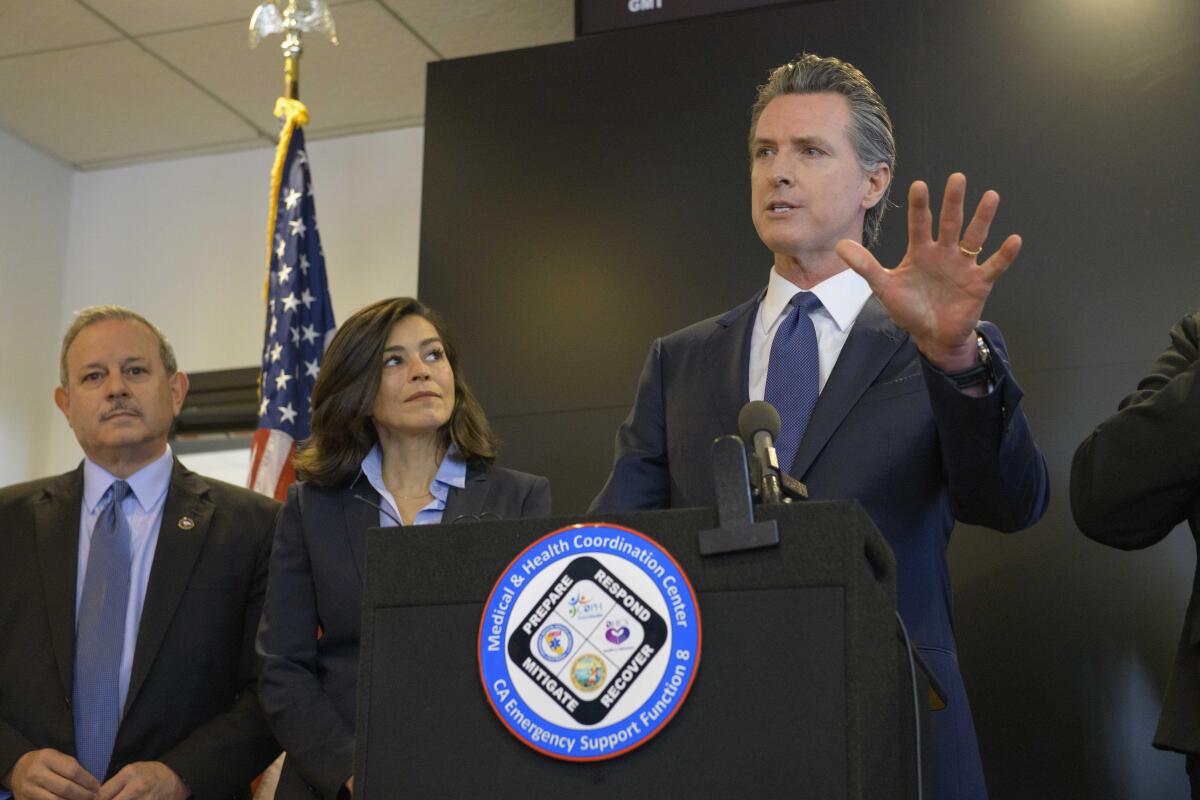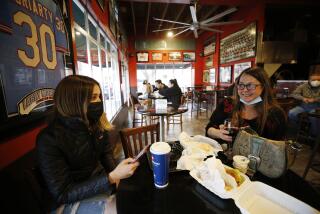More California counties make state coronavirus watchlist as Santa Cruz is removed

- Share via
SACRAMENTO — Gov. Gavin Newsom said Monday that four new counties would be required to close hair salons, gyms and other businesses, marking the first time the state has updated its list of areas experiencing high transmission of COVID-19 in more than two weeks since a massive data flub skewed the count of positive cases.
The state uses the list to monitor surges in coronavirus cases, hospitalizations and community transmissions and to guide decisions on allowing counties to open certain sectors, including schools and in-person services at places of worship.
Officials paused the list at 38 counties on July 31 as the state worked to correct problems with its electronic disease reporting and surveillance system, known as CalREDIE. The data issues caused a backlog of 295,000 coronavirus test results and preceded the sudden departure of the state’s public health officer, Dr. Sonia Angell, who oversaw the reporting system.
Santa Cruz County is now off the list, while Amador, Mendocino, Inyo and Calaveras were added and must close businesses by Thursday. Sierra County was added two days ago and could also be subject to closures if it failed to meet state thresholds for a third day. The governor said he expected San Diego would come off the list this week.
“This is a dynamic list,” Newsom said Monday. “People come on, people come off. The numbers shift every single week. I anticipate this week, the numbers to shift again.”
The state’s watchlist continues to cause confusion. A county’s removal from the list does not immediately allow sectors there to operate without restrictions, and state officials have not yet presented further guidance to counties for moving forward. If a county remains off the list for 14 days, local officials would be allowed to open schools for kindergarten through 12th grade. But indoor operations at shuttered businesses and other affected places would not be allowed to reopen until the state health officer issued a new mandate.
The state informed Santa Cruz County’s health officer Sunday night that it would be removed from the list Monday, an action that has little immediate effect..
“It doesn’t change anything — you have to be off the watch list for 14 days,” county communication officer Jason Hoppin said.
Officials in San Diego County, which is expected to be removed from the watchlist Tuesday, noted that California Health and Humans Services Director Dr. Mark Ghaly said Monday that the state is still updating its guidance and planned to release further information to the counties this week.
“The state is looking at what they’re going to do, but there are no guidelines at this time,” San Diego County Health Officer Dr. Wilma Wooten said during a news briefing. “We need to be patient and wait for guidance to come from the state.”
Inyo County was placed on the list for the first time Monday after cases there spiked following an outbreak at a care center, Assistant County Administrative Officer Leslie Chapman said. Businesses have until midnight Wednesday to make adjustments to their operations.
“We’re just shutting down and trying to help people by expediting permits so people can move their businesses outside,” Chapman said.
Meanwhile, case numbers lost during the CalREDIE glitch were still trickling in to the county. Newsom said that 14,861 backlogged COVID-19 cases have been retrieved, but that counties are still waiting to receive their individual totals.
In Los Angeles County, where health officials announced 19 new coronavirus-related deaths and 1,185 new cases on Monday, officials said they believe that the data would mirror the overall trend in declining cases and hospitalizations.
“We still think we’re missing cases,” Public Health Director Barbara Ferrer said Monday during a news briefing, adding that local officials are still working with the state to gain an accurate count. “That will obviously affect the rolling averages and our testing positivity rate.”
The breakdown of CalREDIE, which state officials blamed on a mix of technical and human errors, raised concerns about the Newsom administration’s response to the pandemic as California topped more than 625,000 cases of the virus. The problem also magnified the state’s communication issues with county officials, who were left in the dark as to when they might be taken off the list.
“We do not feel we should have been put on the watchlist, that these numbers don’t necessitate that type of extreme action by the state in this case and especially because these numbers are in dispute and remain in dispute at this point in time,” San Mateo County Manager Mike Callagy said during a news briefing last Wednesday. “We don’t know a clear path off this list.”
The decision to freeze the monitoring list frustrated counties across the state that had seen drops in cases and in the rates of positive test results. They believed they were eligible to reopen businesses again but were forced to wait for the state to fix the system.
Officials in Orange and San Diego counties thought they had reached the threshold to be removed from the watchlist last week but said they did not know if or when that might occur.
In Orange County, Supervisor Michelle Steel said Thursday that although the local outlook was promising, the data problems and their consequences had been of concern.
“For months now, [the Board of Supervisors] has asked questions and raised concerns about the data,” Steel said of Orange County’s request for information on how the data were recorded. “Our cities rely on this data to best determine how to respond to the change in case count and COVID-19-related deaths.”
The California Department of Public Health said counties were removed from the monitoring list and allowed to reopen businesses once they met the state’s thresholds for three consecutive days. Although the state’s COVID-19 website has no description of how counties are removed from the list, a spokeswoman for the agency said the state communicated changes daily in phone calls or emails to local health departments.
More to Read
Sign up for Essential California
The most important California stories and recommendations in your inbox every morning.
You may occasionally receive promotional content from the Los Angeles Times.















